You're Petting Your Pets All Wrong!
Dr. Marty Becker, Fear Free
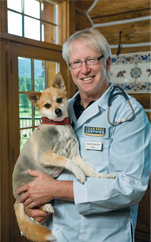 Dr. Marty Becker is back with new research that shows you may be petting cats and dogs improperly. This is especially important if you're a veterinarian. The Fear Free Pets movement wants us to rethink how we interact with our four-legged friends.
Dr. Marty Becker is back with new research that shows you may be petting cats and dogs improperly. This is especially important if you're a veterinarian. The Fear Free Pets movement wants us to rethink how we interact with our four-legged friends.
Developed Dr. Marty Becker, the Fear Free initiative aims to "take the 'pet' out of 'petrified'" and get pets back for veterinary visits by promoting considerate approach and gentle control techniques used in calming environments.
Utilization of Fear Free methods and protocols leads to reduction or removal of anxiety triggers, which creates an experience that is rewarding and safer for all involved, including pets, their owners, and veterinary health care teams. The end result? Calmer, more accepting patients, more compliant clients and better veterinary care.
"Fear Free" ended the year 2016 with 7,000 individuals registered for certification, which included both veterinarians and technicians.
Dr. Becker states he is not gifted like Temple Grandin and has not had a gift since he was a child that is now manifesting in his later part of life. He is just somebody who was moved by a veterinary behaviorist into taking action to reduce fear, anxiety and stress and to look at the emotional well-being of animals.
There will be 12 Fear Free symposiums this year. The first one has already been held in Tampa, Florida. At this symposium, there were 300 people in the room learning about how to reduce fear and anxiety and stress and how to increase enrichment activities in pets.
One of the things they talked about was re-teaching people how to pet a dog and how to approach a dog, as well as how to pet a cat (or not to pet a cat!) and how to approach a cat.
This got Dr. Becker's attention, because three years ago an animal behaviorist once said to him, "There's no other way to tell you this, but you're petting dogs wrong."
Dr. Becker was shocked. How do you pet a dog wrong when you've petted a dog since you were a little kid and it seemed to work? But what he was doing, which is what most people do in the veterinary profession, is to approach a dog from the front, because they love dogs. So when they see a dog, they get excited and want to know about the dog, it's breed, etc. Next they lean down over it and start petting it on the head or the first spot they can reach.
 Well, first of all, dogs have great peripheral vision (meaning they can see things on the sides by their eyes when looking straight ahead). However, they have really terrible vision above them.
Well, first of all, dogs have great peripheral vision (meaning they can see things on the sides by their eyes when looking straight ahead). However, they have really terrible vision above them.
Look around you - you can probably see things on the ceiling or in the air, without looking directly up, because we can see above. However, when you approach a dog and go to pet it from above, they tend to snap because they can't see.
Places you don't want to pet a dog are on the top of the head. You don't want to pet them down the dorsal midline either (just between the shoulder blades). These are mistakes Dr. Becker made frequently.
The places dogs like best to be petted are down the side of the neck, the side of the chest and at the base of their tail. And when you pet them, make it more like a little scratch.
For cats, Dr. Becker already knew not to touch their stomachs. But they also don't like to be touched on their neck or down the dorsal midline. However, they do like to be petted at the base of their tail.
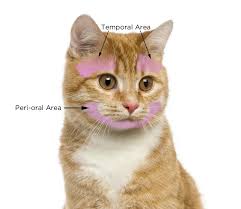 The three best spots to pet a cat are on the lips, the chin, the hairless areas above their eyes and the cheeks as long as you don't touch their whiskers.
The three best spots to pet a cat are on the lips, the chin, the hairless areas above their eyes and the cheeks as long as you don't touch their whiskers.
They are now teaching people in the veterinary community when petting cats, "Don't go below the neck unless you're engaged!"
Another practice in the veterinary community they are changing is when you clean a cage holding an animal; don't place them in another clean cage with a new litter box and new food bowl. This is wrong. Cats love to establish their scent and they have already established their scent in this little area and you are stripping it all off and putting them in an area with no scent, which causes an immense amount of stress.
The proper way is to spot clean and to use products that don't destroy the olfactory neurons by using new hydrogen peroxide cleaners that are like killing machines, which just break down into water and oxygen.
Remember when cats were sent home after a vet visit or stay? As soon as the cat entered the home and was released from the carrier the other cats would attack it? There's a better way. Now we know to leave them in the carrier when you get home and place the carrier on opposite sides of the door from the other animals. Then you take a towel and wipe down all the cats, including the one returning home, with the same towel so that everyone feels and smells a little different.
To learn more about Fear Free, whether you are a veterinarian or a pet parent, or if you are looking for a Fear Free Veterinarian, or if you want your veterinarian to become Fear Free Certified, visit FearFreePets.com. This year they are also certifying households to become "Fear Free Happy Homes."
 How to NOT Train a Dog - Dr. Debbie
How to NOT Train a Dog - Dr. Debbie
The other day I was walking my dog in a community area and encountered a lady with two Shih Tzu's. As we approached, her dogs rallied with barking and tugging on their leashes. I asked if her dogs were friendly, so as to decide if we could approach. The lady scowled, embraced her still barking dogs and grumbled, "Do they look like they're friendly?"
Realizing this dog owner was more unsociable than her dogs, I decided to vamoose, but not before I envisioned this blog topic - how pet owners mold unsocial dog behavior.
Unwanted doggie behavior such as lunging and barking on the leash become established when the dog owner hasn't made it clear what the appropriate behavior is, fails to correct and redirect to a more suitable behavior, or simply reinforces the undesirable behavior through actions or words. Face it - there aren't bad dogs, just poorly trained ones.
Avoid making these top 5 training mistakes:
1. Secluding Your Dog in the Backyard
Keeping your dog in lock down almost guarantees problem behaviors will develop such as biting, inter-dog aggression and phobias to anything from noises to car travel. Isolated dogs lack the experience and confidence when faced with novel situations while socialized dogs adapt easily.
I see it all the time - the dog owner prides herself in keeping her dog safe. "I didn't want Fido to catch any diseases as a pup, so I didn't let him out of our backyard till he was a year old." The overwhelming fear of infectious diseases like parvovirus causes some well-meaning owners to confine their new dog or puppy to the limits of house and yard. Even more extreme is never allowing a puppy to step foot outside until after their last puppy vaccinations! Puppies are most adaptable to new experiences between 6 and 16 weeks - this is the time to expose them to unfamiliar places, people and animals.
That doesn't mean you should take your eight week old puppy to dog parks, but rather to use good sense selecting low dog traffic areas and visiting with family and friends outside of the home that have properly vaccinated pets.
2. Skipping Obedience Training
Going to school is a must for any new dog to a home, whether a puppy or adult. No two dogs are the same, and each learns differently. Formal obedience training is a useful tool to gently reaffirm who's in charge and sets the rules in the house. Statistics show that dogs that go through formal obedience training are less apt to develop behavior problems and be relinquished to shelters.
 3. Reinforcing Fear at the Veterinary Office
3. Reinforcing Fear at the Veterinary Office
In the exam room I cringe when I see a dog owner comforting a nervous, fearful or aggressive pet. That "good boy" and pat on the head reinforces your dog's behavior, making it more likely that on the next hospital visits he'll behave the same, or worse. Some problem behaviors escalate making it difficult for the veterinary staff to examine or treat the animal. This may mean additional costs for sedation or anesthesia for routine medical needs.
It's natural for a pet owner to want to reassure a pet when he is frightened and it can be difficult to hold back the urge to soothe him. However, the best strategy is to ignore those fearful behaviors in the vet office. Don't be tempted to kiss, snuggle or hold Fido on your lap when he is misbehaving. Rather, place the dog on the floor, refocus your dog's attention to you, and cue him to "sit" or "lie down."
4. Not Using Food as a Reward
Food shouldn't just be for the taking. Don't leave food out for your dog to graze whenever he wants and don't give treats just for the sake of giving a treat. Present food and treats as a reward for good behavior such as sitting quietly, going to a pillow, or performing a trick or obedience work. This places you at the top of the household hierarchy. You become the provider of great edibles in the house, and your dog will be motivated to listen to your requests in other situations.
We all love to spoil our dogs and give treats at times. But be sure to give treats for a reason, or you will have a spoiled doggie brat on your hands.
5. Not Exercising Your Pet Enough
Inadequate exercise can result in obesity and boredom, and may lead to problem behaviors like separation anxiety, destructive chewing and excessive barking. Dogs should get 30 to 60 minutes of sustained physical activity each day for optimum mental and physical benefit. And no - letting Buffy run around the backyard during the day is not adequate exercise.
Not all breeds are cut out for all exercise - a Labrador may enjoy retrieving games or swimming, a Jack Russell terrier may thrive with jogging or Frisbee, while a Basset hound will be satisfied with a leash walk.
Your dog can't be a well-adjusted, socialized canine citizen without you, as the pet owner, taking an active role in training. Put the time in, and you'll be thanked many times over with an outgoing, friendly canine pal that can accompany you on life's adventures.
Featured veterinarian known as "Dr. Debbie" on national pet radio program, Animal Radio. Ebook author of "Yorkshire Terriers: How to Be Your Dog's Best Friend"; "Pugs: How to Be Your Dog's Best Friend"; "Mini Schnauzers: How to Be Your Dog's Best Friend"; and "Shih Tzu: How to Be Your Dog's Best Friend."
Visit Website
A Million Reasons Why I'm A Pet Parent
Robert Semrow, Listomania
 Many of us have been engaging in a familiar discussion in the pet world since a Canadian judge ruled that a dog is a dog and shall legally, at least in Canada, only be considered property. In fairness, the judge had some good points. So does this judge's ruling end the discussion? Maybe in Canada, but we've all got neighbors we ignore and this topic continues to rage on.
Many of us have been engaging in a familiar discussion in the pet world since a Canadian judge ruled that a dog is a dog and shall legally, at least in Canada, only be considered property. In fairness, the judge had some good points. So does this judge's ruling end the discussion? Maybe in Canada, but we've all got neighbors we ignore and this topic continues to rage on.
This is a ridiculous argument over how someone views themselves; do they say they are a pet parent, pet guardian, pet owner or pet friend? Does it really matter? I could go on for days about why I am a proud pet parent, but this is a short segment.
The definition of a parent is to protect or to guardian with love and discipline. So why the fuss about them being called property or possessions? Let me know count the ways till Hal cuts my mic...
Possessions don't have heartbeats, they don't have souls, don't need daily care, don't have minds, don't laugh, don't smile, don't snuggle, don't eat, don't drink water, don't care for humans, don't give humans freedom from physical and mental challenges, don't visit hospitals, don't put others before themselves and they don't care if you are happy or sad or they can make you smile or warm your heart.
Property is often easily replaceable. I will not put my life at risk for my property, but I will gladly do so for my family.
I will stop what I am doing for the sake of my pets, but not my possessions. I care about my pets' physical, emotional and behavioral health. I am never alone with my pets around and I can find joy in anything involving my pet, just like my children. I receive friendship, companionship and inspiration in my pet, but not from my possessions. We provide for, teach and give them medical care and they teach and care for us as well.
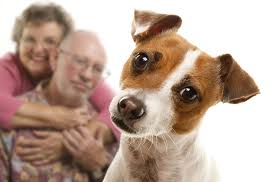 Property exists while pets thrive...
Property exists while pets thrive...
I'm a pet parent because I am willing to treat and care for my animal friends as I would another member of my family. And no, not at the expense of human family members.
What matters is not that I call myself a proud pet parent, but that I care for amazing beings and value them more than possessions. If you consider yourself something else, that's fine too. The real issue is that we live up to the needs that the pets in our lives deserve.
Speaking of that, our pets deserve to have a plan in place so if our lives change due to medical, work or personal issues, they are not left in limbo or their existence left for a court to decide.
Put me down as a very proud and blessed pet parent. My pets have changed my life more than it ever could be by a possession.
Now that I think about, your honor, you may be right, My Pets adopted my family and me. I don't own them, but I am very blessed to acknowledge that they own me.
Let us know if you are pet parent on our Animal Radio Facebook Page.
Visit Website
Animal Radio News - Lori Brooks
 Dogs Don't Like Baby Talk
Dogs Don't Like Baby Talk
Most of us baby talk to babies and our dogs, but maybe we should just limit it to puppies because it turns out older dogs aren't so impressed with our baby talk. A new study shows that baby talk, also known as dog-directed speech when you're conversing with your dog, gets a big response from puppies, but older dogs really couldn't care less. The study's researchers had 30 female volunteers look at photographs of dogs while reading standard dog-directed phrases, like "Who's a good boy?" and "Hello cutie!" The volunteers also read the doggie praise to a human. The researchers found that women used the higher-pitched, singsong baby-talk tone when reading the passages to the photos, making their voices 21-percent higher when reading to the puppy images. With the human, they spoke in their normal voice. That was more or less expected. But when the researchers played recordings of the women's voices to ten puppies and ten adult dogs at a New York animal shelter, there was a stark contrast. The puppies went wild when they heard the baby talk, barking and running toward the loudspeaker, crouching down in a pose used to start a round of play. However, when researchers played the same phrases using the women's normal tone of voice, the puppies weren't nearly as enthused. The adult dogs, however, were a different story. They didn't care at all. They had a quick glance at the speaker and then ignored it. There's no clear reason why the puppies reacted so strongly to the baby talk and the mature animals didn't. It's possible the higher-pitched tones stimulate a special response in the puppies, much like human babies.
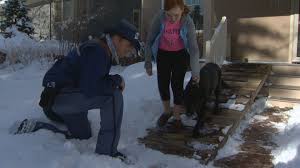 Mailman Builds Ramp So Elderly Dog Can Continue to Greet Him
Mailman Builds Ramp So Elderly Dog Can Continue to Greet Him
Every morning for the last few years, Tashi the black lab went outside to greet his local mailman, Jeff Kramer, a totally dog-loving mailman. Now that Tashi is 14-years-old, however, his joints have become pretty stiff and he doesn't get around as well as he used to. For Tashi to go up and down their front porch steps his parents have to pick him up and carry him and he weighs 70 pounds! Enter Jeff the mail carrier/carpenter. On his most recent day off, he popped over to Tashi's house and built a new ramp for the aging lab and his humans. It turns out that Jeff had a senior dog in the past that he had made a ramp for at his home and thought Tashi could benefit from one as well.
 Pet Owners Fined for Animals Left Out in Cold
Pet Owners Fined for Animals Left Out in Cold
In Yakima, Washington, authorities are giving a warning to unkind pet owners after receiving reports of animals being left outside in frigid temperatures. Since the beginning of last month, animal control has already responded to at least 60 animal welfare checks. Pet owners could face a misdemeanor charge for animal neglect if their pets are found in distress and given a fine from $250 to $5,000 depending on the severity. Yakima police say, "The intent really isn't to criminalize or to give people tickets or citations," but that the welfare of the animal is most important so they try to work with the pet owner. All pets left outside that they check on must have food, water and shelter that will keep them warm enough in freezing weather conditions.
 No Pets in The White House - But VP Doesn't Disappoint!
No Pets in The White House - But VP Doesn't Disappoint!
When Vice President-Elect Mike Pence and his family moved into the Naval Observatory last week, a new furry friend accompanied them: a rabbit named Marlon Bundo. Marlon the rabbit also accompanied the Pences to D.C. on Air Force Two, the vice president's plane, recently. The Pences also have two cats, Oreo and Pickle. We're hoping that by now Oreo and Pickle have gotten used to the leftover smells from the Biden's German Shepherd, Champ.
 Cats Share iPads With Each Other
Cats Share iPads With Each Other
It turns out you can teach an old cat new technology. Felines being cared for at the Regina Humane Society in Saskatchewan, Canada, get to play interactive games on iPads, usually games that feature moving fish, mice or insects that the cats try to "catch" with their paws. Of course cats love to hunt and stalk things and what the programs do is give shelter cats the opportunity to do that on the iPads. The humane society started experimenting with the cat-oriented iPad games, which are downloaded from iTunes, in the fall. The cats have other toys to play with, but the iPads are just one method they use to keep the cats happy and calm. Beyond benefitting the shelter cats, tablets are also a great way to get younger human volunteers engaged in playing with the cats. The human in charge of the iPad program at the shelter says the most surprising thing was how good the cats are at sharing. They usually use the iPads in communal areas where there are multiple cats roaming freely and he said the cats will gather around it and almost take turns playing and chasing the images on the screen. Many times that leads to them playing with each other and increasing their socialization skills.
 There's a Recipe For Cats and Dogs To Get Along
There's a Recipe For Cats and Dogs To Get Along
Cats and dogs really can get along to the point that they'll play hard together, drink water from the same bowl and cuddle on the couch, according to research led from Tel Aviv University. They discovered the recipe for success is to adopt the cat first and introduce a dog while both pets are still young. In homes where the cat and dog are mates, the research suggests they've managed to correctly read each other's body cues.
 Panda Given Spanish Name - Not Traditional Chinese Name
Panda Given Spanish Name - Not Traditional Chinese Name
In Spain, the Madrid zoo has named its latest baby giant panda Chulina, which means Cutie. The name pays homage to Chulin, the first panda born at the zoo 34 years ago. It's an unusual name for a Giant Panda since they are usually given names in their native Chinese. Cutie is five months old now and is the fifth panda to be born at Madrid's zoo.
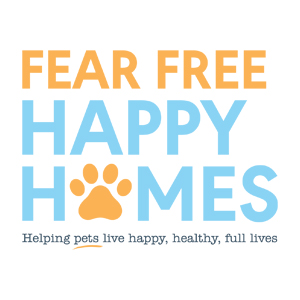
NEWS UPDATE brought to you by Fear Free. "Take the 'pet' out of 'petrified'" and get pets back for veterinary visits by promoting considerate approach and gentle control techniques used in calming environments.
 Listen to the entire Podcast of this show (#895)
Listen to the entire Podcast of this show (#895)



 Dr. Marty Becker is back with new research that shows you may be petting cats and dogs improperly. This is especially important if you're a veterinarian. The Fear Free Pets movement wants us to rethink how we interact with our four-legged friends.
Dr. Marty Becker is back with new research that shows you may be petting cats and dogs improperly. This is especially important if you're a veterinarian. The Fear Free Pets movement wants us to rethink how we interact with our four-legged friends. Well, first of all, dogs have great peripheral vision (meaning they can see things on the sides by their eyes when looking straight ahead). However, they have really terrible vision above them.
Well, first of all, dogs have great peripheral vision (meaning they can see things on the sides by their eyes when looking straight ahead). However, they have really terrible vision above them.  The three best spots to pet a cat are on the lips, the chin, the hairless areas above their eyes and the cheeks as long as you don't touch their whiskers.
The three best spots to pet a cat are on the lips, the chin, the hairless areas above their eyes and the cheeks as long as you don't touch their whiskers.  How to NOT Train a Dog -
How to NOT Train a Dog -  3. Reinforcing Fear at the Veterinary Office
3. Reinforcing Fear at the Veterinary Office
 Many of us have been engaging in a familiar discussion in the pet world since a Canadian judge ruled that a dog is a dog and shall legally, at least in Canada, only be considered property. In fairness, the judge had some good points. So does this judge's ruling end the discussion? Maybe in Canada, but we've all got neighbors we ignore and this topic continues to rage on.
Many of us have been engaging in a familiar discussion in the pet world since a Canadian judge ruled that a dog is a dog and shall legally, at least in Canada, only be considered property. In fairness, the judge had some good points. So does this judge's ruling end the discussion? Maybe in Canada, but we've all got neighbors we ignore and this topic continues to rage on.
 Property exists while pets thrive...
Property exists while pets thrive...
 Dogs Don't Like Baby Talk
Dogs Don't Like Baby Talk
 There's a Recipe For Cats and Dogs To Get Along
There's a Recipe For Cats and Dogs To Get Along
 Panda Given Spanish Name - Not Traditional Chinese Name
Panda Given Spanish Name - Not Traditional Chinese Name
